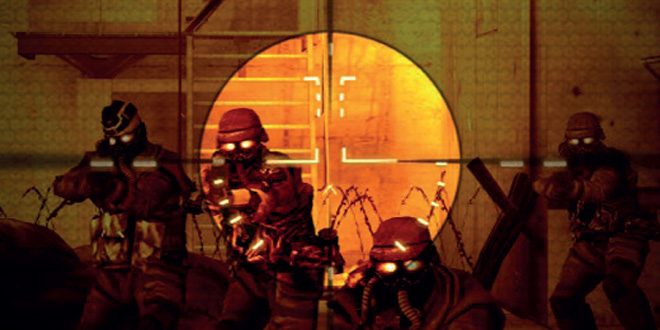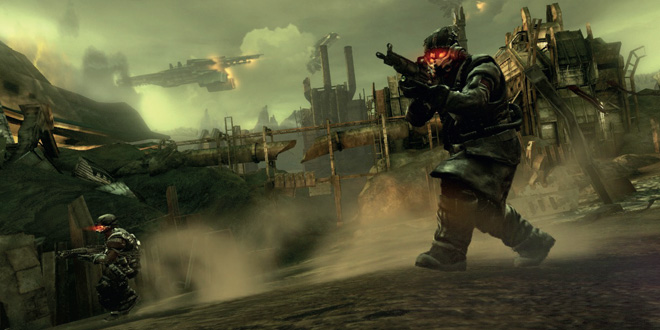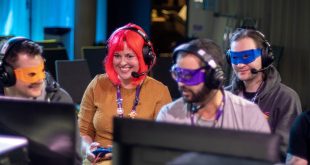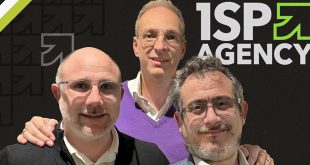

 Vince Pavey met with Jan-Bart van Beek, Michiel van der Leeuw and Angie Smets from PlayStation Studios to ask them all about their journey from Helghan to the Forbidden West before they all go out and hunt another robot dinosaur at the 2023 Develop:Brighton conference.
Vince Pavey met with Jan-Bart van Beek, Michiel van der Leeuw and Angie Smets from PlayStation Studios to ask them all about their journey from Helghan to the Forbidden West before they all go out and hunt another robot dinosaur at the 2023 Develop:Brighton conference.
Guerrilla is now a prestigious 350+ person PlayStation Studios developer based in Amsterdam, known around the world for the creation of hit sci-fi video game franchises like Killzone and Horizon, but it wasn’t always that way, and its early days were rocky.
The studio started life in 2000 as Lost Boys Games, following the merger of multiple Dutch game developers, and it spent most of its time before 2004 working on smaller releases and licensed games. While everyone got to know each other, and the soldiers of the Interplanetary Strategic Alliance were still just a twinkle in a team of developers’ eyes, was that time a period of healthy experimentation, or did it feel more like jumping from raft to raft and trying to stay afloat?
“It was actually a little bit stranger than that. We came together from three different studios.” says Jan-Bart van Beek, co-studio director at Guerrilla. “We had one group that was completely dedicated to Game Boy Advance that made like a game every six months. We had a team that was working on the Dreamcast on their own engine. We had a huge team with a background of working on Unreal that then started making their own tech. So it was very chaotic back then. It took us a while to really make choices about the things that we weren’t gonna do in the future. At some point it became clear we had this opportunity with PlayStation to start making the first Killzone, then we really wanted to embrace that and put all these different groups behind this one effort to create success for the studio.”

“It was so many different things at the same time – pitching, trying to get publishing deals and funding,” says Michiel van der Leeuw, technical director at Guerrilla. “I remember going on an aeroplane with Martin de Ronde to the UK and I think we were visiting like five or six publishers. They were all in London and we had multiple projects, and were trying to pitch to whichever publisher there was. Eventually Killzone made it through. That was also our most ambitious project I think, and where we sort of fell in love with Sony.”
“Halo had already been announced officially, though it was still an Apple product at that point,” adds van Beek. “GoldenEye had a couple of years of big success. Half Life was already out, I think. It was this thing, like, ‘oh, first person shooters are going to be a big new genre’ and they weren’t really on consoles yet. So we asked ‘is it possible to make a first person shooter for the PlayStation 2 platform?’”
“The ‘super powerful PlayStation 2’,” says Angie Smets, head of Development Strategy at PlayStation Studios, cheekily. “I remember you actually calling me when the deal was signed with PlayStation. You were super excited, and were like, ‘It’s gonna be on PlayStation 2’. Then you told me to come and help. I was so impressed because the PlayStation 2 at that time was by far the most powerful machine you could imagine as a creative.”
“They were advertising it as military grade hardware. Because it had maybe a gigaflop. That made it military specs,” laughs van Beek.
“It was a great machine. Hard to program for, I think,” muses Smets. “That was our first big console game. I guess we were sort of blessed with ambition and confidence and being super naive at the same time. I remember you saying, ‘Other people make games for PlayStation. Why can’t we do it?’
“I think we worked a little bit too hard. We were like, ‘Yeah, we really need to get better at this making games thing.’ We want to keep doing this. It needs to be easier. We need to get better at the whole process.”

“We also had so many logistical things to worry about that now aren’t a problem anymore, like sending builds in the mail. On a Friday night, you had to send your milestone builds to the publisher. Your deadline was very physical, because some person was going to show up at your door and take a disc and send it to your publisher. Making a build took like an hour and a half. I remember stalling the courier to make sure that the physical disc could finish burning,” says van der Leeuw.
“We once had a very important milestone build that we were very happy about. We were done and getting everything wrapped up and had to burn the disc … and then the power went out in the centre of Amsterdam. Some people had already gone to a local grocery store to get crates of beer because it was a Friday evening. We were standing there, we were already drinking beer. Suddenly, there’s no power. We had to actually call Sony and say ‘I’m sorry you’re not going to get your milestone deliverable because the power went out.’ It sounded like such a lame excuse but it was a very legitimate explanation.”
“Sounds like ‘the dog ate my homework!’” laughs van Beek.
“Even back in those days, I think the relationship with Sony was always quite good. Thankfully, over the years that only got stronger,” says Smets.
HALO KILLER?
Killzone 2 made an immediate splash for mindshare of the PlayStation 2, stepping into the spotlight at E3 2005 with an impressive trailer that made a lot of other console shooters of the time simply look like they didn’t know what they were doing yet. Others would say that Killzone was the PlayStation 2’s answer to Halo, which had been released around three years earlier on the original Xbox. But was that ever said internally? Did the studio ever feel pressure from their publisher to beat Halo?
 “It wasn’t said internally, but it did just appear on a magazine cover. It was suddenly so important and we were all like ‘Really? What?! We’re not making anything like Halo. We’re making something completely different,’” remembers van Beek.
“It wasn’t said internally, but it did just appear on a magazine cover. It was suddenly so important and we were all like ‘Really? What?! We’re not making anything like Halo. We’re making something completely different,’” remembers van Beek.
“Bungie were a very well renowned company of veterans that knew what they were doing,” says van der Leeuw. “We were a bunch of youngies trying to act like a game company. We had no experience.”
“They had already shipped Marathon at that point,” remembers van Beek. “Halo was something that had been developing for quite a long time. It had a lot of hype behind it, and they were making excellent games for Xbox and Xbox 360.’
“At one point we heard from Edge Magazine, and they were like ‘We’re interested in putting you on the cover.’ We had to source artwork and everything,” continues van der Leeuw. “Then the magazine came out and it had the Killzone artwork and said ‘Halo killer?’ or something, and we were just like, ‘Seriously?’ I mean, the good thing about it was that we had naive ambitions and it made us run. We were a little bit out of our depth because it was so hard to invent everything for the first time. Killzone was maybe not the most polished game, but I’m very proud of it. If you look back at it, we did a lot of things for the first time not just for ourselves, but also for the industry.”
“I think internally, we looked up to Bungie,” says Smets. “We were definitely comparing ourselves. Once that magazine cover came out, that was sort of out there.”
Guerrilla was considered a purely first-person shooter studio for a long while, with some justification, having developed five Killzone games over seven years. Thankfully, after some initial unease, Sony (which had acquired Guerrilla in 2005 after the first Killzone released) was soon on board for Horizon and all it had to offer.
“I think Sony was initially really surprised that we didn’t want to continue Killzone, because it was doing fine,” explains van Beek. “Horizon was a very audacious proposition to them. They were like, ‘You really think this is gonna be popular to the audience?’ It’s not contemporary. It’s not a shooter. It’s not a sports game. It’s a fantasy sci-fi mix. There isn’t anything like that. So when they saw it they were like, ‘Oh. Yeah. I guess that this is what you guys are gonna do now.’”
“I think we started talking about doing something different from Killzone during development on Killzone 3,” says Smets.
“The flame of Killzone was dying a little bit internally,” remembers van Beek. “We had told the stories that we wanted to tell and we didn’t really know what to do further with it. There was plenty of discussion on doing another shooter franchise, but ultimately, what we felt like we really wanted to do is make almost like a 180 on Killzone. We wanted to do something that was inviting, with characters that had an automatic appeal instead of being very scary or gloomy. Something that was much more hopeful.”

“What I really liked was the process that we used. We basically asked the whole studio to pitch ideas for a new franchise, for new game concepts,” says Smets. “I think we got 35 pitches, with lots of different ideas. There were quite a few recurring themes that JB just mentioned, with the more hopeful tone or colorful worlds. There were still science fiction themes. There was a zombie shooter in there. Lots of robots in all of the concepts. It was a great way to see what the team actually wanted to make.”
While the team on Killzone started out with wanting to make a first person shooter for consoles, the approach to Horizon was different.
“With Horizon, it almost started more with the world. We had this sort of premise. An interesting mystery,” says van Beek, describing their post-post-apocalypse. “We had the idea that this would be basically a robot hunting game, but what exactly that would mean back then wasn’t necessarily clear yet. We always sort of stuck to that original idea of the world overrun by robots, and people inhabiting that. Then we asked what the gameplay that you do is, instead of going from the gameplay and finding a world for it.
ENGINE STRANDING
That world and the adventure taken in it was built in the studio’s Decima Engine, rather than in a third party engine used by most of the industry like Unreal. Decima is powerful software that is adapted to the team’s vision rather than the other way around, and it turns out it has quite a lot of history behind it that predates its latest name.
“We’ve always had our own engine tech. We never throw anything away, from the Killzone engine to the Killzone Shadow Fall engine, everything was evolved,” explains van der Leeuw. ”At some point we rebranded it Decima. We wanted to have a cool name when Hideo Kojima was announcing that he was using our engine for Death Stranding. When we went on to Horizon Forbidden West, we had this idea that to make something so ambitious, we needed to really invest in tools and technology and workflow much more because for this amount of content, if we want to be on par, or better than the rest, we need to make sure that we’re the best of the best.
“We also just didn’t want to look like a game that everyone could make. We wanted to make something where we were not limited by the technology that everybody else had. Also by the way we work, we’ve managed to attract so many people who are really inventive, and who can make new stuff that is as good as or better than something else. So it only made sense to just go ahead and make something of equal quality or better.”

“I think the beauty of having our own engine in this case is also that it really allows us to invest exactly in those elements that we want to make important for our next game,” says Smets.
“When we released Horizon Zero Dawn, a lot of people looked at open world games and said ‘Oh, it doesn’t look pretty’,” continues van der Leeuw. “That’s because it’s an open world game. Players had an expectation that open world games would not look as good, or did not have a good framerate, or did not have the technical expertise of first person shooter games, and they were often sort of forgiving the fact that it was technically a little bit less. We wanted to show that you can make a game that’s open world which delivers the same sort of quality level and technical expertise as what you would expect from a shooter game. We got pretty close.”
GAMES ARE ABANDONED
When creating a sequel to a big open world action adventure game like Horizon Zero Dawn, deciding what needs to be improved and what should mostly be left alone is difficult. Does it come down to examining feedback, implementing ideas that didn’t make it to the finish line last time, and then throwing in some extra cool ideas for good measure?
“We really wanted to go forward in terms of the experience from Zero Dawn. We were never really that charmed by how our conversations worked,” says van Beek. “They were very sort of generated and stilted. That was one area where we wanted to bring in a lot more drama and personality. We felt like we could do better storytelling if we improved that. Another aspect of the first game where we took it and made it much bigger was mounts. We took things into the sea as well as into the air just to get a broader range of gameplay features in there.”
“At some point you run out of time when you make a game. Games are never finished. They’re abandoned,” adds van der Leeuw. “Everybody always has more wishes and more dreams. We look at the intersection of our own dreams and at the audience’s response and then put stuff into the mix, including some cool things that you would never ask for.”

“… and sometimes you just need another game to make it work. The flying, for instance, was in very early prototypes of Horizon Zero Dawn. We experimented with flying but it was just too much. It was too much, too soon,” explains Smets.
“There was a push on technology, but it’s also design work,” continues van der Leeuw. “Yeah, can you make it work, but can you make it fun? Because the game design gets so much more complex. Flight adds a layer of freedom, but you have to confine yourself at some point. I think Horizon Zero Dawn as our first open world game was pretty good. It was confined but it was not small. It was definitely not tiny. With Forbidden West we tried to make a lot of the dreams that people had come true.”
Once the ideas for a sequel were in place, was it important to make sure it still felt a follow up to what came before?
“When developing, we do loads and loads of repeating and tweaking,” says van der Leeuw. “There are so many things that you didn’t see in the final game that we scrapped because it didn’t feel right.”
“We go back to the game pillars a lot,” adds Smets. “The feeling of being a robot hunter is something that we fall back on. We don’t want you to feel like you’re a soldier here. You are a hunter and with that comes very distinct, different behaviours.”
With that said, some design aspects to open world games just make sense, and there’s not really much need to rethink them.
“I think initially when we started the first Horizon, we didn’t really know that much about making open world games,” reveals van Beek. “So we got a lot of designers and engineers in from other companies to talk about their experiences and maybe what they expected from an open world editor, for example. So maybe you automatically get that mix of that industry DNA into these things. Maybe there are sort of idioms within open world design that people have gotten acquainted with, so you’re almost bound to need to copy certain things so that people understand vaguely what they’re looking at. You do get some influences there regardless.”

The Horizon series has without a doubt been a success story for PlayStation and Guerrilla, even though each of the main releases in the series so far has launched near to a critical darling of the open world genre, like Breath of the Wild, or Elden Ring. A lot of games would simply not have made it against those juggernauts, but it’s clear that the series has draws of its own that the leadership behind the game are always keen to celebrate.
“I think that the character has a lot of appeal,” says van Beek. “Aloy feels relevant to a lot of people. They can understand her and relate to her and that in itself is a great thing. I also think the core combat is simply quite good. It’s fun to go out there and just hunt the robots, even if that’s the only thing they do. It’s something that is very enjoyable to keep doing over and over.
“I like the world. I think that it’s a very beautiful world to be in and explore,” adds Smets.
“It stands on its own. There isn’t anything like it, really,” agrees van Beek. “You have Assassin’s Creed and it focuses mainly on recreating historic places. You have Red Dead that has the very particular feel of GTA. It also has a very particular theme. The sort of world that we’re creating, this sort of green apocalypse, really hasn’t really been explored to that extent yet.”

 MCV/DEVELOP News, events, research and jobs from the games industry
MCV/DEVELOP News, events, research and jobs from the games industry




